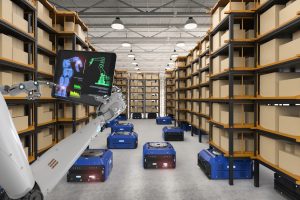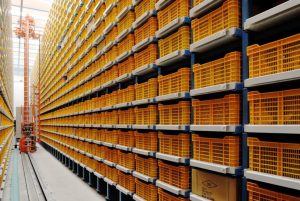Senior Consultant, Rob Palin provides an overview of the various automation technologies commonly used in warehousing as part of BoxLogic’s warehouse automation and robotics insights series. This will be followed by numerous articles from the rest of the team providing extra detail for each technology type to help you understand the available technology solutions and where they might best be used.

What is warehouse automation?
In its most simplistic terms, warehouse automation can be defined as using technology to replace manual processes within a warehouse. In this article we will explore the different types of automation technologies on the market, and some of the key terms and concepts.
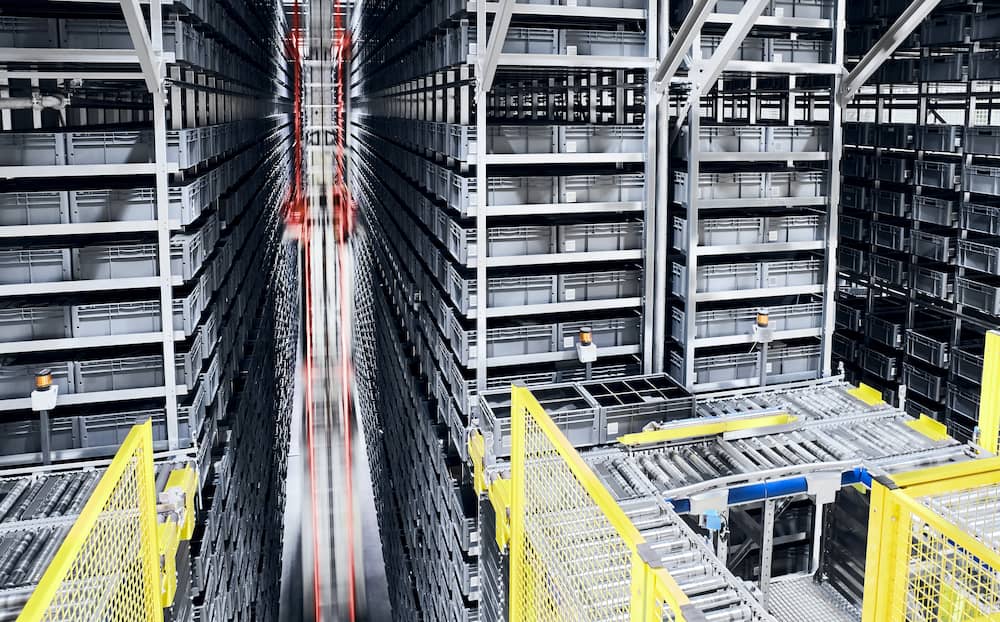
Why is warehouse automation deployed?
The primary reason that businesses invest in warehouse automation is to reduce operational costs. Operational cost savings come in several forms and a business case is usually built up on a broader set of benefits, but the main reasons include:
Benefit | Description |
|---|---|
Lower labour costs | Equipment performs tasks previously performed by people |
Lower footprint costs | Automated solutions require less space to operate meaning reduced rent, property rates and utility costs |
Lower energy costs | Automated areas do not require as much lighting, saving capital investment and operational costs as lighting accounts for ~ 65% of typical warehouse energy consumption |
Greater operational resilience | Lower dependency on labour mitigates against issues of sickness and labour availability constraints affecting many countries and driving up labour costs |
Improved accuracy | Automation is less likely to pick the wrong items or cause product damage with reduced human touches |
Improved workplace safety | Improved ergonomics and reduced movement reduce the physical and mental stress where people remain in operation |
When does warehouse automation and robotics work best?
Warehouse automation is not feasible in all operations or at least it can be prohibitively expensive in many cases. A return on investment might not be available or it might not meet the hurdle rate, as defined by a company, meaning the capital is better invested in other areas or left in the bank altogether.
Certain operational characteristics, however, do support shorter or better business cases when it comes to automation:
Factor | Description |
|---|---|
High labour costs | Typically, the single biggest factor as areas with higher labour costs generate larger savings from replacing labour with MHE |
High footprint costs | High footprint costs generate larger savings from the reduced operating space, especially in buildings with higher clear heights |
High throughputs | Larger throughputs allow the investment costs to be spread over a greater number of tasks |
Steady demand profile | Any investment needs to be sized appropriately and larger peak-to-average throughput ratios require greater automation capacity, and therefore cost, that might only be used during one or two weeks of the year |
Online order fulfilment | Online orders take more resource to fulfil than wholesale orders or store replenishment, therefore automation can save more labour due to the lower productivities of a manual operation |
Tiers of warehouse automation
Warehouse automation can be broken down into three tiers.
Each of these levels of automation can be deployed simultaneously at various points through the process to create an advanced integrated solution to leverage the relative skills of people, software, and equipment. This might include multiple handoffs back and forth between people and equipment as well as software systems.
Warehouse Mechanisation
The implementation of simple technology that assists people with tasks that would otherwise require low skilled manual labour. For example, a conveyor moving inventory from point A to point B. Read more in our Warehouse Mechanisation post.
Warehouse System Automation
This type of automation uses software, machine learning, robotics, and data analytics to automate tasks and procedures. For example, a warehouse management system can review an entire day’s orders and produce the most efficient batching and pick routing, so that operatives do not have unnecessary travel around the warehouse.
Integrated Warehouse Automation
This kind of warehouse automation uses robotic equipment and systems to assist humans with physical warehouse processes. An example may be the use of autonomous mobile robots that lift racks of products and deliver them to human pickers. The humans pick the required products, and once complete, the robots return the racks back to their storage location. This is also known as ‘goods-to-person’ picking.
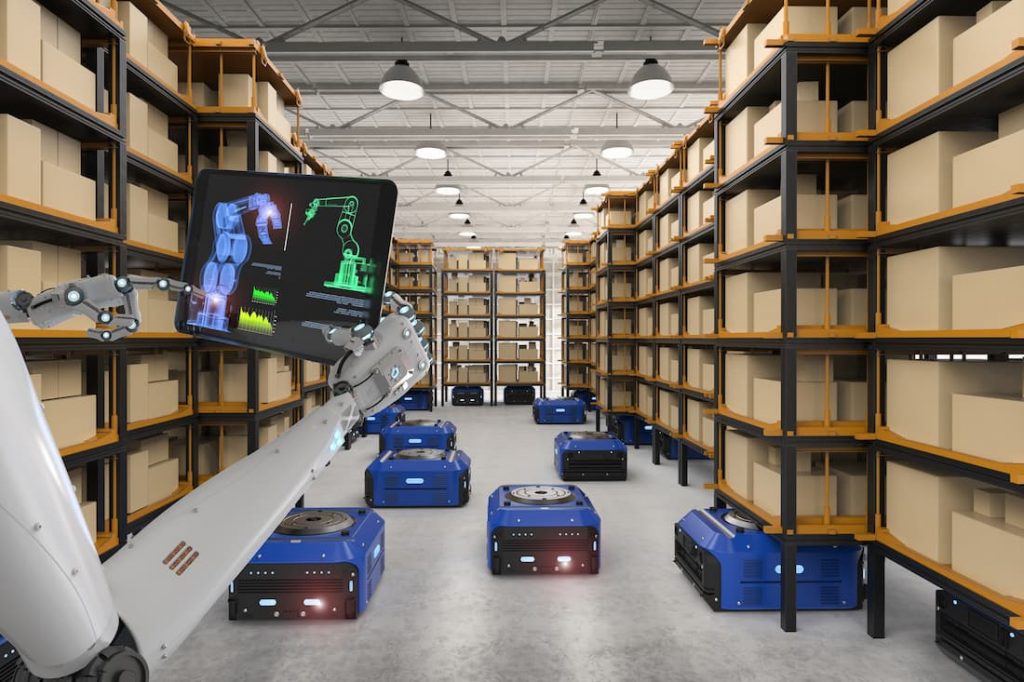
Key Terms and Automation Concepts
Warehouse automation technologies can be divided up into the following uses of transport carriers, discrete equipment, person-to-goods picking, goods-to-person picking and machine learning.
Transport Carriers
This involves the use of equipment or technology to move products between two points. These two points may be on the same level or different levels i.e., ground to a mezzanine floor level.
Discrete Equipment
Discrete equipment might include single pieces of material handling equipment (MHE) used within a manual operation or potentially integrated into a mechanised or highly automated solution.
Person-to-Goods (P2G)
A traditional picking method. People travel to where the goods are stored in the warehouse to complete their pick. This can be inefficient, so a WMS (Warehouse Management System) can provide picking strategies such as wave or batch picking to increase travel efficiency. Cobots can also be used to drive further efficiencies.
Goods-to-Person (G2P)
The process of a desired product being brought to people at dedicated workstations. In a manual environment, this could be a person on a forklift bringing product to the picking team. In an automated solution, this could be completed by a conveyor bringing products to a person; or by a fleet of autonomous robots bringing product to the humans. These are combined with an AS/RS system.
Machine Learning
A type of artificial intelligence whereby software learns to become more accurate in predicting outcomes. A great example of Machine Learning can be found in robotic piece picking. The SKU range for retailers is changing all the time and robots need to learn to handle a huge range of items in both dimensions, weight, load centre, and material. They also need to be able to respond to an item presented to the robot at any different angle or orientation and the robotic picking arm is constantly learning to find the quickest and most reliable to handle items in addition to placing items in a tote to maximise tote-fill.
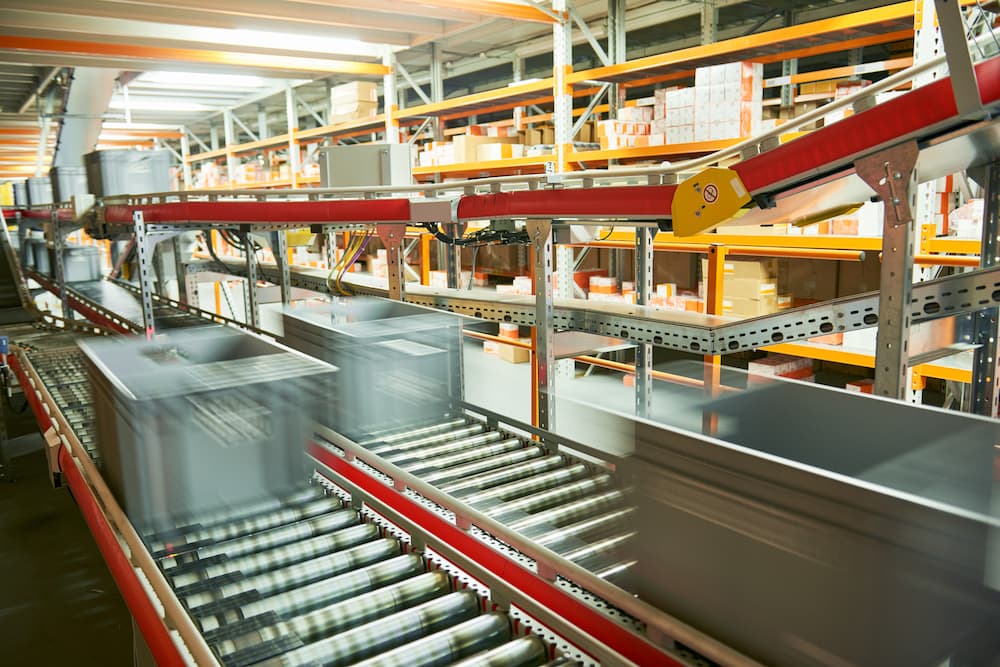
Warehouse Automation Technology Overview
There are many different types of automated warehouse equipment, and these will be outlined in this post. Over the coming weeks as part of our automation technology series, we will go into more detail on each type of equipment.
Manual
Manual technologies are still appropriate for many operations and include the use of various types of racking and shelving for storage in addition to forklift trucks, trollies, or gravity conveyor to support the movement, putaway or retrieval of goods. Find out more about manual storage options in our bulk manual storage or manual small pick post.
Mechanisation
Mechanisation is a general term referring to the replacement of a human task through the introduction of equipment into a discrete process or activity. It doesn’t usually require much, if any, integration and is often quite ‘dumb’, performing a single task, supported by people. Such examples might include conveyors or lifts to move products between two points; pick to light systems to support a bulk pick and outsort process; stretch wrapping devices etc. Learn more in our Warehouse Mechanisation post.
Unmanned Ground Vehicles (UGV)
UGV is a collective term for robots that do not need a driver; rather, they are controlled remotely or via sensors, QR codes. There are many types of UGVs, such as Autonomous Mobile Robots (AMRs), Autonomous Guided Vehicles (AGVs) and Collaborative Robots (Cobots). At a basic level, these can replace manual forklift tasks or conveyors, or they can be integrated into full goods-to-person or sorting solutions. Learn more in our UGV, AMR and AGVs post.
Hive Storage
This is sometimes referred to as Grid, Cube or Hive. Imagine a large 3D grid, within each square on the grid are stored products in totes. Robots traverse across the top of the grid putting away, retrieving, or moving totes between workstations. Hive technology is highly scalable and offers super dense storage as there are no aisles or clearance between storage totes.
Examples of this technology in use can be found in Ocado fulfilment centres or in implementations of AutoStore, although similar technologies are also being developed
Sorters
Sortation is the process of identifying individual items and diverting them to specific locations. For example, items could be sorted onto a conveyor travelling to a pick/pack station, or into a specific bin destined for returns processing. There are many types of sorters, which depend on the type required application. Sorters include cross-belt, bomb-bay, tilt-tray, and pocket sorters. AMRs can also be used to create sortation solutions.
Shuttles or Cranes
The most traditional form of AS/RS (automated storage and retrieval system) can handle pallets, cartons, or totes. Whether a shuttle system or a crane system is used depends on the relationship between storage and throughput. Palletised and carton systems are used as bulk or reserve storage whilst carton or tote systems are often paired with goods-to-person pick stations.
Robotics
Robotic arms are being used more and more within warehouses. Common examples include palletising robots, that automatically stacks product onto pallets, but can also include robotic arms for picking individual units into totes or sorting items by order.
How do you know which technology is right in your operation?
BoxLogic have a wealth of experience in warehouse design projects for a variety of cross-sector clients. From identifying suitable types of automation, analysing expected benefits and ROI timescales, through to shortlisting and suggesting vendors. Our independence means that we identify the most appropriate solution for you. If there is no case for automation, we will recommend a manual solution and help you design it.
BoxLogic is well positioned to assist you with your next Warehouse Automation project. Contact us to discuss your project today.


